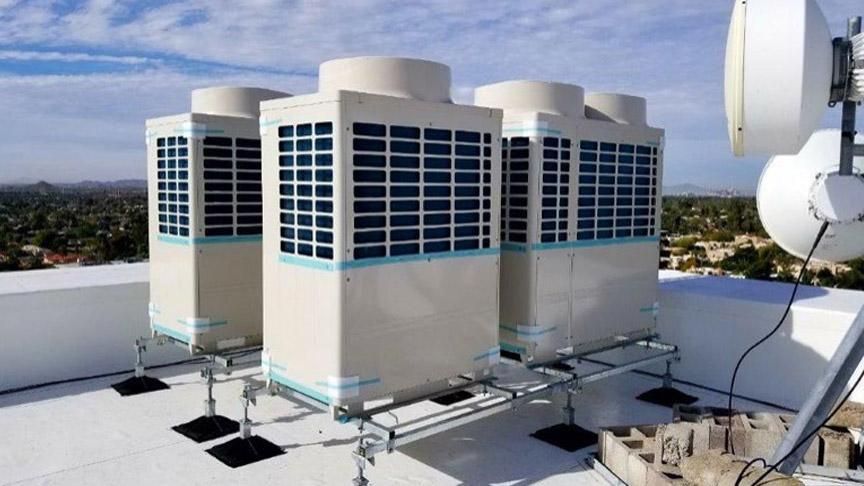As single ply membrane roofs become increasingly popular thanks to their many advantages, those working with these delicate roofs need to be aware that they can be easily damaged when using traditional methods to mount plant on them. Our Technical Marketing Manager at Big Foot Systems, explains how non-penetrative, repeatable support structures are the ideal solution.
Single ply membrane roofs are on the rise. Building Regulations and modern methods of construction are driving the specification of this quick to install solution which allows early interior fit-out, offers low capital and in-use costs and gives design flexibility. But if everyone working on the rooftop is not aware of its fragility, there is a high risk of damage which would negate its many benefits. By working together, roofing contractors and M&E contractors can ensure that any plant is safely installed whilst keeping the rooftop intact, avoiding call backs for roof repairs.
So what is single ply membrane? It’s created from strong and flexible membranes, composed predominantly of synthetic polymer, that are sealed at joints to form continuous waterproofing. When combined with insulation and continuous support, they make complete, durable roof systems. It ranges in thickness from 1.1mm to +2mm and offers a huge range of geometric and performance options. Single ply membrane roofs offer many advantages such as high thermal performance, effective control of air leakage and the elimination of cold bridging by using thermal break fasteners. It is also safe to use, with flame-free construction using hot-air welding, adhesives and fasteners.
However, these benefits can be threatened if no consideration is given to the plant and equipment that may be housed on the flat roof and how to reach and install it. Single ply membranes are sensitive to footfall and can be damaged by traffic on flat roofs. Whether walking on the roof or installing plant, anything which cracks or punctures the waterproofing membrane can potentially cause leaks. Roofing contractors are therefore set the challenge of ensuring that, whether planned from the start, amended part way through a job or added at the end, whoever is installing the rooftop plant understands how to work with single ply membrane.
A number of methods have traditionally being used to install rooftop plant but these can have drawbacks with modern roofs. Concrete paving slabs are simple, speedy and cheap but if placed directly on a single ply membrane roof can tear through the membrane, which can lead to destructive roof leaks and costly damage. Steel fabrications for heavier plant penetrate the roof membrane at specified points, requiring remedial works to seal the roof around the penetrations. This can compromise roof integrity causing thermal bridging, possible leaks, or potentially affecting roof warranty requirements.
So with traditional installation methods being less than ideal on single ply membrane roofs, what is the best solution? Non-penetrative, repeatable support structures, which are configurable for each individual project and have the added benefit of being cost effective.
For example, Big Foot Systems’ modular non-penetrative framework systems are ideal for installing ac units and heavier plant on flat roofs without damaging a delicate single ply membrane roof. The Light Duty Range is quick to install, robust and offers an array of solutions to support a variety of extract and supply fans, air conditioning, VRV & VRF units and small air handling units. Meanwhile, the Heavy Duty Range offers a cost and time effective alternative to on-site construction steel fabrications. Ideal for supporting heavier plant on flat roofs, such as large packaged plant rooms and chillers, these systems are also very stable, offering a greater degree of protection against tipping, and manage the load evenly and over a greater area ensuring it is within workable loads of the roof specification. Big Foot also calculates the number and size of foot bases in contact with the roof to ensure the individual foot pressures do not exceed the insulation and membrane specifications under compression.
With both these systems it is recommended that an isolating material (sacrificial layer) is placed between the roof and the non-penetrative framework. This is necessary since single ply membrane and the frameworks’ rubber matt (on the underside of each leg assembly) are of a similar chemical composition and so polymer migration can occur, bonding the two together over time. Adding a sacrificial layer on top of the single ply membrane protects the delicate roof.
For contractors, non-penetrative support systems tick all the right boxes. Quick and easy to install, they provide excellent support for HVAC plant whilst maintaining the integrity of the roof membrane. Whether specified at the beginning of a project or to answer an emergency call as a construction deadline looms, non-penetrative supports offer the ideal solution when it comes to installing plant on single ply membrane roofs.
For further information on all products and services offered by Big Foot Systems email: [email protected] or telephone 01323 844355.
A number of methods have traditionally being used to install rooftop plant but these can have drawbacks with modern roofs. Concrete paving slabs are simple, speedy and cheap but if placed directly on a single ply membrane roof can tear through the membrane, which can lead to destructive roof leaks and costly damage. Steel fabrications for heavier plant penetrate the roof membrane at specified points, requiring remedial works to seal the roof around the penetrations. This can compromise roof integrity causing thermal bridging, possible leaks, or potentially affecting roof warranty requirements.


















